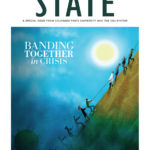Illustration by Dave Cutler
We are reaching you with three special issues this spring and summer – combining STATE, the magazine of the CSU System, and Colorado State Magazine, the publication for alumni and supporters of our flagship university. These issues are smaller, more frequent, and are mailed to a combined readership. This allows us to conserve resources, deliver timely articles, and stay in touch during a critical time.
The calendar has turned to July, and this pandemic’s layers and their severity are impacting all of us.
In the United States, there are nearly 4 million confirmed cases of COVID-19 and almost 141,000 deaths; the numbers are surging as this magazine is published. Our national and state economies are haltingly reopening after widespread closures and a U.S. unemployment rate that hit 14.7 percent in April, the highest level since the Great Depression. Our country is also beset with volatile protests and urgent demands for racial equity and justice after the shocking death in Minneapolis of a Black man, George Floyd, in police custody.
The combination is agonizing.
The stories, columns, and essays in this second special issue of STATE, focused on the COVID-19 pandemic, demonstrate a path forward for our university communities; in fact, the only path forward. We must band together to identify, confront, and solve problems. This need goes well beyond a vague spirit of togetherness. Now, the need to band together requires strenuous joint effort, aimed at overcoming a multilayered crisis unlike anything in memory.
In this edition, you will see how people in our CSU System and its broader communities are joining ideas and efforts to adapt to and effect change. You will find stories of real commitment and creativity – of the front line and the overtime.
In these stories, you will learn about the hows of adaptation and change. Equally important are the whys. In our university System, our work centers on opportunity in its most encompassing sense – opportunity for individual, societal, environmental, and economic health and well-being.
It’s no wonder, then, that I see colleagues working around the clock through this crisis. The proof comes in middle-of-the-night emails from researchers waging assaults on COVID-19; from administrators examining budgets, health and safety policies, and equity practices; and from educators who fervently wish to see students in person, in good health, and back on campus.
As we band together, we are making progress.





